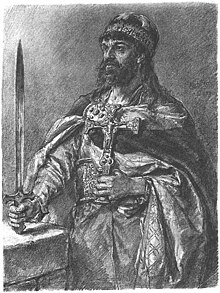
Back ميشكو الأول Arabic ميشكو الاول ARZ Miecislao I AST I Meşko Azerbaijani بیرینجی میشکو (لهیستان) AZB Мешка I Byelorussian Мешка I BE-X-OLD Мешко I Bulgarian Mješko I, knez Poljske BS Miecislau I de Polònia Catalan
| Mieszko I | |
|---|---|
 Mieszko as imagined by Jan Matejko in the 19th century | |
| Duke of Poland | |
| Reign | 960–992 |
| Predecessor | Siemomysł |
| Successor | Bolesław I the Brave |
| Born | c. 930 |
| Died | 25 May 992 (aged 61–62) Poznań, Poland |
| Spouse | Doubravka of Bohemia Oda of Haldensleben |
| Issue more... | Bolesław I the Brave Świętosława Vladivoj, Duke of Bohemia (?) Mieszko Świętopełk Lambert |
| Dynasty | Piast |
| Father | Siemomysł |
| Religion |
|
Mieszko I (Polish pronunciation: [ˈmjɛʂkɔ ˈpjɛrfʂɨ] ⓘ; c. 930 – 25 May 992)[1] was the first ruler of Poland and the founder of the first independent Polish state, Civitas Schinesghe also known as the Duchy of Poland. His reign stretched from 960 to his death and he was a member of the Piast dynasty, a son of Siemomysł and a grandson of Lestek. He was the father of Bolesław I the Brave (the first crowned king of Poland) and of Gunhild of Wenden.[2] Most sources identify Mieszko I as the father of Sigrid the Haughty, a Scandinavian queen (though one source identifies her father as Skoglar Toste), the grandfather of Canute the Great (Gundhild's son) and the great-grandfather of Gunhilda of Denmark, Canute the Great's daughter and wife of Henry III, Holy Roman Emperor.
He was the first Christian ruler of Poland. He continued the policies of both his father and grandfather, who initiated the process of creation of the Polish state. Through both alliances and military force, Mieszko extended ongoing Polish conquests and early in his reign subjugated Kuyavia and probably Gdańsk Pomerania and Masovia. For most of his reign, Mieszko I was involved in warfare for the control of Western Pomerania and eventually conquered it up to the vicinity of the lower Oder river. During the last years of his life, he fought the Bohemian state and won Silesia and Lesser Poland. He is sometimes called the "Clovis of Poland" for his role in the founding of Christian Poland.
Mieszko I's alliance with the Czech prince, Boleslaus I the Cruel, strengthened by his marriage in 965 to the Czech Přemyslid princess Dobrawa, and his baptism in 966 put him and his country in the cultural sphere of Western Christianity. Apart from the great conquests accomplished during his reign, which proved to be fundamental for the future of Poland, Mieszko I was renowned for his internal reforms, which were aimed at expanding and improving the so-called war monarchy system.
According to existing sources, Mieszko I was a wise politician, a talented military leader and a charismatic ruler. He successfully used diplomacy by concluding alliances, first with Bohemia, then Sweden and the Holy Roman Empire. In foreign policy, he placed the interests of his country foremost, even entering into agreements with his former enemies. On his death, he left to his sons a country with greatly expanded territories and a well-established position in Europe.
Mieszko I also enigmatically appeared as "Dagome" in a papal document dating to about 1085, called Dagome iudex, which mentions a gift or dedication of Mieszko's land to the Pope (the act took place almost a hundred years earlier).
It is roughly to his borders that Poland was returned in 1945.
- ^ Historical dictionary of Poland. Greenwood Publishing Group. 1996. ISBN 978-0-313-26007-0.
- ^ Prinke, Rafał T. "Świętosława, Sygryda, Gunhilda. Tożsamość córki Mieszka I i jej skandynawskie związki [Świętosława, Sygryda, Gunhilda. The identity of Mieszko I's daughter and her Scandinavian relationships".
© MMXXIII Rich X Search. We shall prevail. All rights reserved. Rich X Search